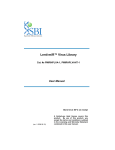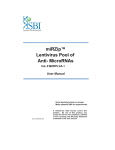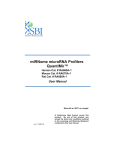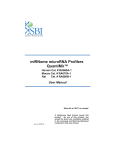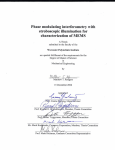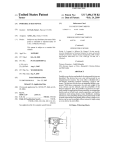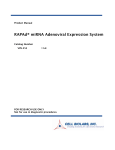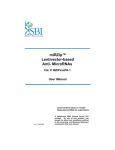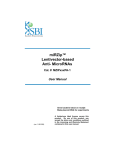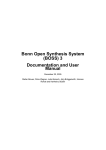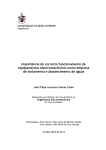Download MicroRNA Constructs Manual
Transcript
Lentivector-based MicroRNA Precursor Constructs Cat. # PMIRHxxxPA-1 User Manual Grow bacterial stock on receipt Make plasmid DNA for experiments (ver. 2008-02-28-001) A limited-use label license covers this product. By use of this product, you accept the terms and conditions outlined in the Licensing and Warranty Statement contained in this user manual. MicroRNA Precursor Constructs Cat. #s PMIRHxxxPA-1 Contents I. Introduction and Background A. B. C. D. E. F. G. Purpose of this Manual Overview Tools for Functional Study of MicroRNA Unique Features of SBI’s MicroRNA Precursor Constructs List of Components Additional Required Materials Safety Guidelines 2 2 2 3 7 7 8 II. Protocol A. Applications of SBI’s MicroRNA Precursor Constructs B. Transfection of microRNA Precursor Constructs C. Packaging SBI’s Cloned MicroRNA Precursor Constructs III. References 9 10 11 12 IV. Appendix A. Map of pMIRNA1 and verifying clone content B. Features of pMIRNA1 C. Properties of copGFP Fluorescent Protein D. Related Products E. Technical Support 13 15 16 16 16 V. Licensing and Warranty Statement 17 ** This Product shall be used by the purchaser for internal research purposes only and distribution is strictly prohibited without written permission by System Biosciences. 888-266-5066 (Toll Free) 650-968-2200 (outside US) Page 1 System Biosciences (SBI) User Manual I. Introduction and Background A. Purpose of this Manual This manual provides details and information about microRNA Precursor Constructs in SBI pMIRNA1 lentivectors (parent SBI vector is pCDH-CMV-MCS-EF1-copGFP; SBI cat# CD511B-1). This manual does not include all the information on packaging the lentivector expression constructs into pseudotyped viral particles or transducing your target cells of choice with these particles. This information is available in the user manual Lentivector Expression Systems: Guide to Packaging and Transduction of Target Cells, which is available on the SBI website (www.systembio.com). Before using the reagents and material supplied with this system, please read the entire manual. B. Overview The term microRNA (miRNA) describes a novel class of small, non-coding RNAs which regulate gene expression posttranscriptionally by disrupting translation or directing cleavage of complementary mRNAs. These 17-26 nucleotide (nt) single-stranded miRNA molecules are synthesized as primary transcripts (pri-miRNA) that are often polycistronic, containing a small number of clustered miRNA units. Following transcription, and while the transcript still remains nuclear, the Drosha RNAse III nuclease processes the pri-miRNA into ~70nt stem loop precursors (pre-miRNA). These pre-miRNA molecules are transported to the cytoplasm by a complex of proteins which includes the dsRNA binding protein Exportin-5, where they are processed to their final mature form by another RNAse III nuclease, Dicer (Lee, 2002, Yi, 2003). It is here in the cytoplasm that mature miRNAs ultimately affect the protein levels of their target mRNAs by binding to complementary regions, and either inhibiting translation, or directing mRNA cleavage (Kim, 2005). Initially discovered in C. elegans as subtle regulators of cell fate, miRNAs have since been identified in all metazoan organisms, controlling such vital processes as cell proliferation, differentiation, signal transduction, and cell death. The lin-4 and let-7 miRNAs of the nematode were found to modulate gene expression by binding to complementary sites in the 3’UTR of the target gene’s mRNA (Lee, 1993, Olsen, 1999). This binding of microRNAs affords the cell post-transcriptional control over gene expression, and adds another layer to the already complex gene expression regulatory network. Recently, miRNAs were implicated in the biogenesis of human diseases. It was shown that human lung cancer tumors had distinctly lower levels of the let-7 miRNA (Johnson, 2005). This is a critical observation, because the RAS proto-oncogene family has sites that are complementary to let-7, enabling let-7 mediated control of RAS expression. RAS proteins were upregulated in these lung tumors, suggesting that the perturbation in let-7 expression led to overexpression of RAS and thus oncogenesis. Viruses which cause human disease also utilize miRNAs to regulate both host and viral gene expression. Pfeffer, et. al (Pfeffer, 2004) found that human cell lines latently infected with Epstein-Barr herpesvirus expressed miRNA of viral origin. Computational analysis of the potential targets of these miRNA revealed predicted interactions with cellular genes involved in proliferation, apoptosis, immune response, and other vitally important pathways. Human immunodeficiency virus (HIV) is also predicted to express a small subset of miRNAs that have a broad range of predicted cellular targets (Bennasser, 2004). Conversely, cellular miRNAs expressed in T-cells are predicted to interact with the viral transcripts (Hariharan, 2005). C. Tools for Functional Study of MicroRNA As the identification of novel microRNAs continues, hundreds of isolated miRNAs and thousands of predicted conserved miRNAs (John, 2006) have been published. Yet, very few have had their functions experimentally validated. There is an increasing need for robust methods to study the functions of each isolated or predicted microRNA. The only commercially available product for the functional study of miRNAs is the collections of synthetic miRNA molecules based on predicted mature miRNA sequence. Despite their optimized design criteria, synthetic miRNAs underscore the importance of primary miRNA in its native expressed form. The primary microRNA contains critical biological components involved in mature miRNA expression and cellular processing, it often been processed into several mature miRNA molecules. The second major drawback of synthetic miRNA molecules is that their knockdown effect in the target cell is transient and usually disappears 2-3 days after transfection. SBI’s microRNA Precursor constructs express each individual miRNA precursor in its native context while preserving putative hairpin structures to ensure biologically relevant interactions with endogenous processing machinery and regulatory partners. The lentiviral expression system also makes it possible to have a stable knockdown effect after being introduced into the cells. Page 2 ver. 2-082412 www.systembio.com MicroRNA Precursor Constructs Cat. #s PMIRHxxxPA-1 D. Unique Features of SBI’s MicroRNA Precursor Constructs System Biosciences’ (SBI’s) microRNA Precursor Construct Collection incorporates several unique features that set it apart from any commercially available miRNA collection. Express microRNA precursor transcripts from their native genomic context The inserts in SBI’s microRNA Precursor Construct Collection represent more than just the mature microRNA sequences listed in Sanger’s miRBase (http://microrna.sanger.ac.uk/sequences/). Each construct in SBI’s collection consists of the stem loop structure and 300-500 base pairs of upstream and downstream flanking genomic sequence. This unique feature ensures that the microRNAs expressed from SBI’s clones act as naturally as possible. The native structure ensures interaction with endogenous RNA processing machinery and regulatory partners, leading to properly cleaved microRNAs. MicroRNA Precursors expressed from SBI's Lentivectors produce Mature microRNAs 888-266-5066 (Toll Free) 650-968-2200 (outside US) Page 3 System Biosciences (SBI) User Manual Lentiviral transduction system is effective and safe Each of SBI’s miRNA precursor molecules has been cloned in a lentiviral-based vector. Like other standard plasmid vectors, SBI’s miRNA construct can be used for transient expression of miRNA using conventional transfection protocols. Moreover, its lentiviral backbone allows each miRNA construct to be packaged in pseudoviral particles and introduced into non-dividing or difficult-to-transfect cell lines. In particular, all of the miRNAs have been cloned in SBI’s HIV-based expression vectors. Replication incompetent HIVbased vectors are considered biologically safe . RNA Polymerase-II promoter ensures robust expression from single copy integrants While pol-III promoters are required to express very short siRNA and shRNA, the primary microRNAs can be expressed using conventional pol-II promoters (Stegmeier, 2005). The traditionally utilized pol-III promoters (H1 and U6) are constitutively expressed in all cell types, which complicates studies where knockdown of a gene product is lethal. Different pol-II promoters can alternatively provide either spatially or temporally defined expression (Shin, 2006). SBI’s microRNA Precursor Clone Collection expresses each miRNA precursor from the CMV promoter. This robust strong viral promoter ensures a high level of expression from a single copy of integrated miRNA construct. Page 4 ver. 2-082412 www.systembio.com MicroRNA Precursor Constructs Cat. #s PMIRHxxxPA-1 Dual expression design simplifies identification of transduced cells The unique organization of the vector (Fig 1.) results in expression of a another downstream transcript containing the copGFP fluorescent marker driven by the Human EF1 promoter (see Fig 2.). Fig. 1. Map of HIV-based lentiviral plasmid expressing one of the microRNA precursors from SBI’s collection. The HIV-1 derived pMIRNA1/pCDH vectors contain the following common features: • • • • • • • • WPRE element—enhances stability and translation of the CMV-driven transcripts. SV40 polyadenylation signal—enables efficient termination of transcription and processing of recombinant transcripts. Hybrid RSV-5’LTR promoter—provides a high level of expression of the full-length viral transcript in producer 293 cells. Genetic elements (cPPT, GAG, LTRs)—necessary for packaging, transducing, and stably integrating the viral expression construct into genomic DNA. SV40 origin—for stable propagation of the pMIRNA1 plasmid in mammalian cells. pUC origin—for high copy replication and maintenance of the plasmid in E.coli cells. Ampicillin resistance gene—for selection in E.coli cells. copGFP—fluorescent marker to monitor cells positive for transfection and transduction. 888-266-5066 (Toll Free) 650-968-2200 (outside US) Page 5 System Biosciences (SBI) User Manual Easily monitor expression-positive cells using GFP fluorescence. Fig. 2. Phase contrast and GFP fluoresence images of 293TN cells after transfection of 500 ng PreMiR-513a-1 construct DNA using Lipofectamine 2000 (Invitrogen). Robust mature miRNAs produced using SBI’s MicroRNA Precursor Constructs. Fig. 3. High levels og miRNAs deteced from pMIRNA1 constructs. Real-time qPCR with the QuantiMir small RNA quantitation system was used to evaluate expression from the pMIRNA clones shown to the left. QuantiMir KIt (SBI cat# RA420A-1). Page 6 ver. 2-082412 www.systembio.com MicroRNA Precursor Constructs E. Cat. #s PMIRHxxxPA-1 List of Components MicroRNA Precursor Construct Collection The microRNA precursor constructs are shipped in bacterial stock form (E. coli) plated on LB-carbenicillin at 50g/ml (same as ampicillin, but more stable over time for shipment). Upon receipt, individual colonies may be apparent already. If no colonies are visible upon receipt, incubate the LBcarbenicillin overnight at 37ºC. If there are no apparent colonies after overnight incubation, please contact SBI immediately for a replacement (650-968-2200). F. Additional Required Materials For Purifying Construct Plasmid DNA after Receipt The microRNA precursor constructs are shipped in bacterial stock form (E. coli) plated on LB-carbenicillin at 50g/ml (same as ampicillin, but more stable over time for shipment). Upon receipt, individual colonies may be apparent. If no colonies are visible upon receipt, incubate the LB-carbenicillin overnight at 37ºC. If there are no apparent colonies after overnight incubation, please contact SBI immediately for a replacement (650-968-2200). Pick a single, isolated colony from the plate and grow a liquid culture of suitable volume in LB-ampicillin (100 g/ml) shaking at 30ºC. Plasmid purification kit (Recommended: QIAGEN Endotoxin-free Plasmid Kit. The following kit combinations can be used for Midi scale (up to 200 g of plasmid DNA) preparation of endotoxin-free DNA: QIAfilter Plasmid Midi Kit, Cat. # 12243, and EndoFree Plasmid Maxi Kit, Cat. # 12362 QIAfilter Plasmid Midi Kit, Cat. # 12243, and EndoFree Plasmid Buffer Set, Cat. # 19048 Please visit the QIAGEN website to download the specialized protocol that is not contained in the current user manual: http://www1.qiagen.com/literature/protocols/pdf/QP15.pdf For Transfection of pMIRNA1 Constructs into Target Cells Transfection Reagent (Recommended: Invitrogen Lipofectamine 2000, Cat. # 11668-027) For Packaging of pMIRNA1 Constructs in Pseudoviral Particles In order to package your pMIRNA1 construct into VSV-G pseudotyped viral particles, you will need to purchase the pPACKH1 Lentivector Packaging Kit (Cat. # LV500A-1). The protocol for packaging and transduction of packaged pseudoviral particles is provided in the User Manual for the Lentivector Expression System. 293 Producer Cell Line (Recommended: SBI 293TN Cell Line, Cat. # LV900A-1 or ATCC 293 Cells, Cat. # CRL-11268) Transfection Reagent (Recommended: Invitrogen Lipofectamine, Cat. # 18324-111 and Plus Reagent, Cat # 11514-015). 888-266-5066 (Toll Free) 650-968-2200 (outside US) Page 7 System Biosciences (SBI) User Manual G. Safety Guidelines SBI’s Expression lentivectors together with the pPACK packaging plasmids comprise the third-generation lentiviral expression system. The HIV-based lentivectors are based on the vectors developed for gene therapy applications by Dr. J. G. Sodroski (US patent #5,665,577 and # 5,981,276). Both FIV-based and HIV-based lentivector systems are designed to maximize their biosafety features, which include: A deletion in the enhancer of the U3 region of 3’LTR ensures self-inactivation of the lentiviral construct after transduction and integration into genomic DNA of the target cells. The RSV promoter (in HIV-based vectors) and CMV promoter (in FIV-based vectors) upstream of 5’LTR in the lentivector allow efficient Tat-independent production of viral RNA, reducing the number of genes from HIV-1 that are used in this system. Number of lentiviral genes necessary for packaging, replication and transduction is reduced to three (gag, pol, rev), and the corresponding proteins are expressed from different plasmids (for HIV-based packaging plasmids) lacking packaging signals and share no significant homology to any of the expression lentivectors, pVSV-G expression vector, or any other vector, to prevent generation of recombinant replication-competent virus. None of the HIV-1 genes (gag, pol, rev) will be present in the packaged viral genome, as they are expressed from packaging plasmids lacking packaging signal—therefore, the lentiviral particles generated are replication-incompetent. Pseudoviral particles will carry only a copy of your expression construct. Despite the above safety features, use of SBI’s lentivectors falls within NIH Biosafety Level 2 criteria due to the potential biohazard risk of possible recombination with endogenous viral sequences to form self-replicating virus, or the possibility of insertional mutagenesis. For a description of laboratory biosafety level criteria, consult the Centers for Disease Control Office of Health and Safety Web site at http://www.cdc.gov/od/ohs/biosfty/bmbl4/bmbl4s3.htm. It is also important to check with the health and safety guidelines at your institution regarding the use of lentiviruses and always follow standard microbiological practices, which include: Wear gloves and lab coat all the time when conducting the procedure. Always work with pseudoviral particles in a Class II laminar flow hood. All procedures are performed carefully to minimize the creation of splashes or aerosols. Work surfaces are decontaminated at least once a day and after any spill of viable material. All cultures, stocks, and other regulated wastes are decontaminated before disposal by an approved decontamination method such as autoclaving. Materials to be decontaminated outside of the immediate laboratory area are to be placed in a durable, leak proof, properly marked (biohazard, infectious waste) container and sealed for transportation from the laboratory. Please keep in mind that pMIRNA1 vectors are integrated into genomic DNA and could have a risk of insertional mutagenesis. Page 8 ver. 2-082412 www.systembio.com MicroRNA Precursor Constructs Cat. #s PMIRHxxxPA-1 Protocol A. Applications of SBI’s MicroRNA Precursor Constructs The major advantage of SBI’s microRNA precursor constructs compared to synthetic microRNA is that our constructs can be integrated into cells via the lentiviral expression system. With the lentiviral system, it is possible to generate stable cell lines that express specific microRNA. Since microRNAs are believed to be involved in various cellular pathways, these stable cell lines would provide a unique tool that allows you to link microRNA with biological functions. To make a stable cell line, you first have to package the construct into pseudoviral particles (see Section B of Protocol). After infecting your target cells with the pseudovirus-containing supernatant, you can isolate infected cells expressing a high level of copGFP by FACS sorting. Cells that stably express specific microRNA precursors can be also used to monitor other gene expression in order to identify miRNA target genes. Alternatively, the microRNA precursor construct can be cotransfected with a reporter construct that expresses putative microRNA target sequences. By measuring the reporter gene expression in transfected or transduced cells, the putative microRNA target gene can be confirmed. 888-266-5066 (Toll Free) 650-968-2200 (outside US) Page 9 System Biosciences (SBI) User Manual B. Transfection of the microRNA Precursor Construct The microRNA precursor construct can be introduced together with a reporter construct into HeLa or HEK 293 cells using chemical transfection. For example, with these cells, the Lipofectamine™ Reagent (Invitrogen, Cat. # 18324-111) with Plus™ Reagent (Invitrogen, Cat. # 11514-015) system works well. Alternatively, you can use your target cells for this analysis. If you have already established a transfection method for your target cells, use your established conditions. If you do not have an established transfection protocol, we recommend you compare efficiencies of several transfection procedures (e.g., Invitrogen’s Lipofectamine™ 2000, Cat. # 11668-027, Clontech’s CLONfectin™, Cat. # 631301). It is important to optimize the selected transfection protocol and keep the parameters constant between testing samples and control samples. Sample Transfection Data Page 10 ver. 2-082412 www.systembio.com MicroRNA Precursor Constructs Cat. #s PMIRHxxxPA-1 C. Packaging SBI’s Cloned MicroRNA Precursor Constructs SBI’s cloned microRNA precursor constructs can be efficiently packaged into VSV-G pseudotyped viral particles using SBI’s pPACKH1 Packaging Plasmid Mix (Cat. # LV500A-1). The provided miRNA precursor expression plasmid was purified using a QIAGEN Endotoxin-free plasmid kit to ensure maximum transfection efficiency. For a detailed packaging protocol, please refer to SBI’s pPACK user manual Lentivector Expression Systems: Guide to Packaging and Transduction of Target Cells, which is available on the SBI website (www.systembio.com) Sample Transduction Data 888-266-5066 (Toll Free) 650-968-2200 (outside US) Page 11 System Biosciences (SBI) User Manual References Bennasser, Y., S. Y. Le, M. L. Yeung and K. T. Jeang (2004). "HIV-1 encoded candidate micro-RNAs and their cellular targets." Retrovirology 1(1): 43. Hariharan, M., V. Scaria, B. Pillai and S. K. Brahmachari (2005). "Targets for human encoded microRNAs in HIV genes." Biochem Biophys Res Commun 337(4): 1214-8. John, B., C. Sander and D. S. Marks (2006). "Prediction of human microRNA targets." Methods Mol Biol 342: 101-13. Johnson, S. M., H. Grosshans, J. Shingara, M. Byrom, R. Jarvis, A. Cheng, E. Labourier, K. L. Reinert, D. Brown and F. J. Slack (2005). "RAS is regulated by the let-7 microRNA family." Cell 120(5): 635-47. Kim, V. N. (2005). "Small RNAs: classification, biogenesis, and function." Mol Cells 19(1): 1-15. Lee, R. C., R. L. Feinbaum and V. Ambros (1993). "The C. elegans heterochronic gene lin-4 encodes small RNAs with antisense complementarity to lin-14." Cell 75(5): 843-54. Lee, Y., K. Jeon, J. T. Lee, S. Kim and V. N. Kim (2002). "MicroRNA maturation: stepwise processing and subcellular localization." Embo J 21(17): 4663-70. Mathijs Voorhoeve, P., C.L. Sage, M. Schrier, A.J.M.Gillis, H. Stoop, R.Nagel, Y. Liu, J.V.Duijse, J. Drost, A. Griekspoor, E. Zlotorynski, N. Yabuta, G. D.Vita, H. Nojima, L.H.J.Looijenga, and R. Agami (2006). “A Genetic Screen Implicates miRNA-372 and miRNA-373 As Oncogenes in Testicular Germ Cell Tumors.” Cell 124, 1169-1181 Olsen, P. H. and V. Ambros (1999). "The lin-4 regulatory RNA controls developmental timing in Caenorhabditis elegans by blocking LIN-14 protein synthesis after the initiation of translation." Dev Biol 216(2): 671-80. Pfeffer, S., M. Zavolan, F. A. Grasser, M. Chien, J. J. Russo, J. Ju, B. John, A. J. Enright, D. Marks, C. Sander and T. Tuschl (2004). "Identification of virus-encoded microRNAs." Science 304(5671): 734-6. Poeschla, E.M., Looney, D.J., and Wong-Staal, F. (2003) Lentiviral nucleic acids and uses thereof. US Patent NO. 6,555,107 B2 Shin, K. J., E. A. Wall, J. R. Zavzavadjian, L. A. Santat, J. Liu, J. I. Hwang, R. Rebres, T. Roach, W. Seaman, M. I. Simon and I. D. Fraser (2006). "A single lentiviral vector platform for microRNA-based conditional RNA interference and coordinated transgene expression." Proc Natl Acad Sci U S A 103(37): 13759-64. Stegmeier, F., G. Hu, R. J. Rickles, G. J. Hannon and S. J. Elledge (2005). "A lentiviral microRNA-based system for single-copy polymerase II-regulated RNA interference in mammalian cells." Proc Natl Acad Sci U S A 102(37): 13212-7. Yi, R., Y. Qin, I. G. Macara and B. R. Cullen (2003). "Exportin-5 mediates the nuclear export of pre-microRNAs and short hairpin RNAs." Genes Dev 17(24): 3011-6.. Pooled Library For added convenience, a pool of prepackaged viral particles containing the entire microRNA Precursor Clone Collection is available. The pooled library can be used for high-throughput phenotypic screens of microRNA function. For general information on screens with pooled microRNA libraries, please see the following references: Voorhoeve PM, le Sage C, Schrier M, Gillis AJ, Stoop H, Nagel R, Liu YP, van Duijse J, Drost J, Griekspoor A, Zlotorynski E, Yabuta N, De Vita G, Nojima H, Looijenga LH, Agami R. A genetic screen implicates miRNA-372 and miRNA-373 as oncogenes in testicular germ cell tumors. Cell. 2006 Mar 24;124(6):1169-81. Huang Q, Gumireddy K, Schrier M, le Sage C, Nagel R, Nair S, Egan DA, Li A, Huang G, Klein-Szanto AJ, Gimotty PA, Katsaros D, Coukos G, Zhang L, Puré E, Agami R. The microRNAs miR-373 and miR-520c promote tumour invasion and metastasis. Nat Cell Biol. 2008 Feb;10(2):202-10. Page 12 ver. 2-082412 www.systembio.com MicroRNA Precursor Constructs Cat. #s PMIRHxxxPA-1 II. Appendix A. Map of pMIRNA1 To sequence your pMIRNA1 clone: EF1 rev primer: 5’ – GCACCCGTTCAATTGCCG – 3’ The sequence read will be the opposite strand of the “sense” strand miRNA precursor. 888-266-5066 (Toll Free) 650-968-2200 (outside US) Page 13 System Biosciences (SBI) User Manual To verfiy the miRNA precursor in your pMIRNA1 clone: Use web BLAST at Sanger miRBase: http://microrna.sanger.ac.uk/sequences/search.shtml STEP 1. Copy/Paste your raw sequence data into the Box above marked “1.”. STEP 2. Selct from the drop-down box the “Stem loop sequences” selection, marked “2.” above. Page 14 ver. 2-082412 www.systembio.com MicroRNA Precursor Constructs B. Cat. #s PMIRHxxxPA-1 Features of pMIRNA1 Feature RSV/5'LTR gag RRE cPPT CMV promoter EF1 copGFP WPRE 3' ∆LTR (∆U3) SV40 Poly-A SV40 Ori pUC Ori AmpR Function Hybrid RSV promoter-R/U5 long terminal repeat; 7-414 required for viral packaging and transcription 567-919 Packaging signal Rev response element binds gag and involved in 1076-1309 packaging of viral transcripts Central polypurine tract (includes DNA Flap 1798-1916 region) involved in nuclear translocation and integration of transduced viral genome Human cytomegalovirus (CMV)--constitutive 1922-2271 promoter for transcription of cloned cDNA insert Elongation factor 1α promoter--constitutive 2315-2860 promoter for transcription of Reporter gene (Puromycin resistance or copGFP) Copepod green fluorescent protein (similar to 2874-3629 regular EGFP, but with brighter color) as a reporter for the transfected/transduced cells Woodchuck hepatitis virus posttranscriptional 3639-4229 regulatory element--enhances the stability of the viral transcripts Required for viral reverse transcription; selfinactivating 3' LTR with deletion in U3 region 4301-4534 prevents formation of replication-competent viral particles after integration into genomic DNA 4606-4737 Transcription termination and polyadenylation Allows for episomal replication of plasmid in 4746-4892 eukaryotic cells 5262-5935 (C) Allows for high-copy replication in E. coli Ampicillin resistant gene for selection of the 6080-6940 (C) plasmid in E. coli Location* * The notation (C) refers to the complementary strand. 888-266-5066 (Toll Free) 650-968-2200 (outside US) Page 15 System Biosciences (SBI) User Manual C. Properties of the copGFP Fluorescent Protein The pMIRNA1 Vector contains the full-length copGFP gene with optimized human codons for high level of expression of the fluorescent protein from the CMV promoter in mammalian cells. The copGFP marker is a novel natural green monomeric GFP-like protein from copepod (Pontellina sp.). The copGFP protein is a non-toxic, non-aggregating protein with fast protein maturation, high stability at a wide range of pH (pH 4-12), and does not require any additional cofactors or substrates. The copGFP protein has very bright fluorescence that exceeds at least 1.3 times the brightness of EGFP, the widely used Aequorea victoria GFP mutant. The copGFP protein emits green fluorescence with the following characteristics: emission wavelength max – 502 nm; excitation wavelength max – 482 nm; quantum yield – 0.6; -1 -1 extinction coefficient – 70,000 M cm Due to its exceptional properties, copGFP is an excellent fluorescent marker which can be used instead of EGFP for monitoring delivery of lentivector constructs into cells. D. Related Products pPACKH1™ Lentivector Packaging Kit (Cat. # LV500A-1) Unique lentiviral vectors that produce all the necessary HIV viral proteins and the VSV-G envelope glycoprotein from vesicular stomatitis virus required to make active pseudoviral particles. 293TN cells (SBI, Cat. # LV900A-1) transiently transfected with the pPACKH1 and a pMIRNA1 microRNA expression construct produce packaged viral particles containing a microRNA construct. 293TN Human Kidney Producer Cell Line (SBI, Cat. # LV900A-1) For packaging of plasmid lentivector constructs. QuantiMir small RNA quantitation system (Cat. # RA420A-1) Easily profile miRNAs using a single cDNA synthesis step and real-time qPCR. LentiMag™ Magnetotransduction Kit (Cat. # LV800A-1) A novel, simple, and highly effective approach to increase the number of cells positively transduced with SBI’s HIV- and FIV-based lentiviral vectors compared to the standard method of Polybrene®-aided transduction. Lentivector UltraRapid Titer PCR Kit (Cat. # LV960A-1 [for human cells], LV960B-1 [for mouse cells]) Allows you to measure copy number (MOI) of integrated lentiviral constructs in genomic DNA of target cells after transduction with constructs made in any of SBI’s FIV or HIV-based Lentivectors or GeneNet™ siRNA Libraries. E. Technical Support For more information about SBI products and to download manuals in PDF format, please visit our web site: http://www.systembio.com For additional information or technical assistance, please call or email us at: System Biosciences (SBI) 265 North Whisman Rd. Mountain View, CA 94043 Phone: (650) 968-2200 (888) 266-5066 (Toll Free) Fax: (650) 968-2277 E-mail: General Information: [email protected] Technical Support: [email protected] Ordering Information: [email protected] Page 16 ver. 2-082412 www.systembio.com MicroRNA Precursor Constructs Cat. #s PMIRHxxxPA-1 III. Licensing and Warranty Statement Limited Use License Use of the MicroRNA Precursor Construct (i.e., the “Product”) is subject to the following terms and conditions. If the terms and conditions are not acceptable, return all components of the Product to System Biosciences (SBI) within 7 calendar days. Purchase and use of any part of the Product constitutes acceptance of the above terms. The purchaser of the Product is granted a limited license to use the Product under the following terms and conditions: The Product shall be used by the purchaser for internal research purposes only. The Product is expressly not designed, intended, or warranted for use in humans or for therapeutic or diagnostic use. The Product may not be resold, modified for resale, or used to manufacture commercial products without prior written consent of SBI. This Product should be used in accordance with the NIH guidelines developed for recombinant DNA and genetic research. HIV Vector System This Product or the use of this Product is covered by U.S. Patents Nos. 5,665,577 and 5,981,276 (and foreign equivalents) owned by the Dana-Farber Cancer Institute, Inc., and licensed by SBI. This product is for non-clinical research use only. Use of this Product to produce products for resale or for any diagnostic, therapeutic, clinical, veterinary, or food purpose is prohibited. In order to obtain a license to use this Product for these commercial purposes, contact the Office of Research and Technology Ventures at the Dana-Farber Cancer Institute, Inc. in Boston, Massachusetts, USA. WPRE Technology System Biosciences (SBI) has a license to sell the Product containing WPRE, under the terms described below. Any use of the WPRE outside of SBI’s Product or the Products’ intended use, requires a license as detailed below. Before using the Product containing WPRE, please read the following license agreement. If you do not agree to be bound by its terms, contact SBI within 10 days for authorization to return the unused Product containing WPRE and to receive a full credit. The WPRE technology is covered by patents issued to The Salk Institute for Biological Studies. SBI grants you a non-exclusive license to use the enclosed Product containing WPRE in its entirety for its intended use. The Product containing WPRE is being transferred to you in furtherance of, and reliance on, such license. Any use of WPRE outside of SBI’s Product or the Product’s intended use, requires a license from the Salk Institute for Biological Studies. This license agreement is effective until terminated. You may terminate it at any time by destroying all Products containing WPRE in your control. It will also terminate automatically if you fail to comply with the terms and conditions of the license agreement. You shall, upon termination of the license agreement, destroy all Products containing WPRE in you control, and so notify SBI in writing. This License shall be governed in its interpretation and enforcement by the laws of California. Contact for WPRE Licensing: The Salk Institute for Biological Studies, 10010 North Torrey Pines Road, La Jolla, CA 92037; Attn: Office for Technology Management; Phone: (858) 435-4100 extension 1275; Fax: (858) 450-0509. CMV Promoter The CMV promoter is covered under U.S. Patents 5,168,062 and 5,385,839 and its use is permitted for research purposes only. Any other use of the CMV promoter requires a license from the University of Iowa Research Foundation, 214 Technology Innovation Center, Iowa City, IA 52242. CopGFP Reporter This product contains a proprietary nucleic acid coding for a proprietary fluorescent protein(s) intended to be used for research purposes only. Any use of the proprietary nucleic acids other than for research use is strictly prohibited. USE IN ANY OTHER APPLICATION REQUIRES A LICENSE FROM EVROGEN. To obtain such a license, please contact Evrogen at [email protected]. SBI has pending patent applications on various features and components of the Product. For information concerning licenses for commercial use, contact SBI. Purchase of the product does not grant any rights or license for use other than those explicitly listed in this Licensing and Warranty Statement. Use of the Product for any use other than described expressly herein may be covered by patents or subject to rights other than those mentioned. SBI disclaims any and all responsibility for injury or damage which may be caused by the failure of the buyer or any other person to use the Product in accordance with the terms and conditions outlined herein. Limited Warranty SBI warrants that the Product meets the specifications described in the accompanying Product Analysis Certificate. If it is proven to the satisfaction of SBI that the Product fails to meet these specifications, SBI will replace the Product or provide the purchaser with a refund. This limited warranty shall not extend to anyone other than the original purchaser of the Product. Notice of nonconforming products must be made to SBI within 30 days of receipt of the Product. SBI’s liability is expressly limited to replacement of Product or a refund limited to the actual purchase price. SBI’s liability does not extend to any damages arising from use or improper use of the Product, or losses associated with the use of additional materials or reagents. This limited warranty is the sole and exclusive warranty. SBI does not provide any other warranties of any kind, expressed or implied, including the merchantability or fitness of the Product for a particular purpose. SBI is committed to providing our customers with high-quality products. If you should have any questions or concerns about any SBI products, please contact us at (888) 266-5066. © 2012 System Biosciences (SBI). 888-266-5066 (Toll Free) 650-968-2200 (outside US) Page 17


















